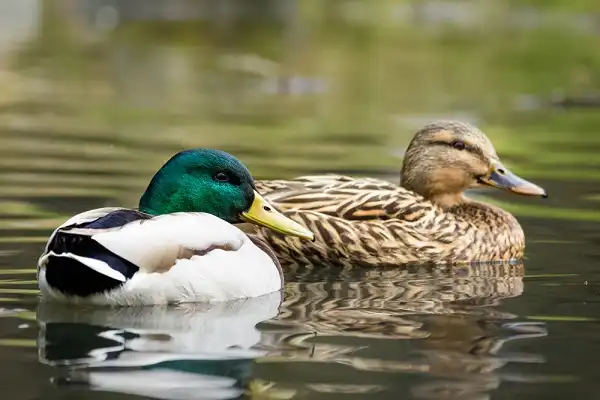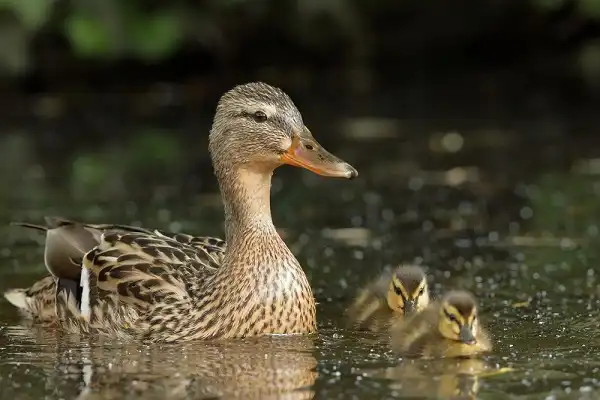From their adorable “quack” to the incredible way they can glide through the water, ducks have been capturing our hearts since time immemorial. Whether you’re an avid duck enthusiast or are just now learning about these exquisite animals, it’s hard not to be fascinated by them! In this blog post, we’ll take a deep dive into why ducks are so unique and amazing. You’ll learn about the different types of ducks and their fascinating behaviors, as well as how humans can help protect and conserve vulnerable duck species for future generations to appreciate.

Duck Description
Ducks are aquatic birds that are found all around the world. They belong to the family Anatidae, which includes swans and geese as well. Ducks come in a wide variety of shapes and sizes, ranging from the tiny teal to the imposing eider duck. One of the most fascinating physical features of ducks is their waterproof feathers, which are densely packed to keep them warm and dry in water. Ducks also have webbed feet that help them to paddle and swim with ease. Ducks are social creatures and are known to form strong bonds with one another. Mating pairs may stay together for several years and raise their offspring together.
Duck Habitat
Ducks can be found in a diverse range of habitats all over the world, including wetlands, rivers, lakes, and even human-made bodies of water like ponds and canals. In fact, some species of ducks have adapted specifically to urban environments and can often be seen paddling around in city parks and waterways. Wetlands, in particular, are crucial habitats for many species of ducks. These areas provide the perfect combination of open water and dense vegetation, which ducks need for feeding, nesting, and rearing their young. Wetland habitats also play a critical role in regulating water flow, filtering pollutants, and storing carbon, making them an essential part of the earth’s ecosystem. In addition to wetlands, many species of ducks also depend on other types of habitats. For example, diving ducks like the canvasback and redhead rely on large, deep lakes and reservoirs for feeding and roosting. Shallow ponds and rivers, on the other hand, are preferred habitats for dabbling ducks like the mallard and pintail, which feed by tipping their heads underwater and grazing on aquatic plants.
Duck Diet
The diet of ducks depends largely on their species. Dabbling ducks tend to feed mostly on aquatic vegetation while diving ducks prefer underwater prey like fish and mollusks. Ducks may also eat insects, amphibians, crustaceans, and even small reptiles or mammals. In addition to foraging for food in the wild, some species of ducks take advantage of human-made sources as well. Domesticated varieties such as the Muscovy and Mallard have been known to scavenge in agricultural fields and other sites where grain is available. Ducks are also able to digest a wide variety of plant materials thanks to a unique digestive system that allows them to extract more nutrients from their food than other waterfowl.
Duck Size
In general, ducks range in size from about 16-26 inches (40-66 cm), with males typically being larger than females. Ducks also come in a variety of colors, including white, black, brown, gray, and even colorful iridescent shades depending on the species. Some duck species have distinct markings that make them easy to identify, like the male mallard’s bright green head or the female canvasback’s striking white back. Others can be harder to tell apart due to their more subtle coloration.

Duck Lifespan
The average lifespan of a duck varies greatly depending on the species and environmental conditions. In general, ducks in captivity may live up to 15 years, while those in the wild may only survive for a few years. Predators and disease are major threats to duck populations, as are human disturbance and habitat loss. With proper care and protection, however, some species of ducks can live significantly longer than average. For example, mallards have been known to reach 25 years of age in captivity. Ducks also benefit from conservation efforts that protect their habitats and ensure they have access to an adequate food supply throughout the year. With our help, these remarkable creatures will continue to thrive for many generations to come.
Duck Behavior
Ducks are highly social creatures that live in flocks and display a wide range of behaviors. Some species form monogamous pairs that stay together for many years, while others engage in cooperative breeding where one male mate with multiple females. Ducks communicate with each other using various vocalizations, from loud honking to more subtle whistles and caterwauling. When foraging for food, ducks typically stick close to their flockmates. They mostly hunt alone or in small groups, but some species have been known to use hunting strategies like forming “encircling arcs” to increase their success rate. Ducks also practice cooperative care of chicks and will often act aggressively toward predators if they feel their young are threatened.
Duck Speed
Ducks are fast swimmers, able to reach speeds of up to 8 mph (13 km/h). They use their webbed feet as powerful paddles underwater and can also take off from the water’s surface with relative ease. In flight, ducks usually travel in large flocks at speeds of up to 40 mph (64 km/h). Some species even fly thousands of miles during their annual migrations. In addition to being strong swimmers and capable fliers, ducks are also agile on land. They have short legs with strong toes that allow them to walk easily across most terrain. And their wings provide added stability when running or taking off from the ground. Ducks may appear clumsy, but their agility and speed are actually quite remarkable.

Duck Hunting
Duck hunting is a popular sport enjoyed by many people around the world. It involves using decoys, calls, and other techniques to attract ducks within shooting range. The practice of duck hunting dates back centuries and has had a major influence on the development of modern firearms and waterfowl conservation efforts. Most states in the U.S. regulate duck hunting according to species, season length, bag limits, and other restrictions. These regulations are intended to help ensure that populations remain healthy while still allowing hunters to enjoy their sport responsibly. Duck hunters must also adhere to specific safety protocols like wearing blaze orange during certain times of the year and avoiding firing near populated areas or bodies of water. Ultimately, duck hunting can be a safe and enjoyable activity when pursued with respect for the environment and the animals involved. By following regulations and practicing ethical behavior, hunters can ensure that their sport remains sustainable for generations to come.
Duck Migration and Flight Patterns
Ducks are well known for their impressive migratory capabilities, as many species fly thousands of miles yearly in search of better food and living conditions. Ducks typically travel in large flocks while migrating, forming distinctive V-shaped formations with the lead birds taking turns at the front to reduce wind resistance. Most ducks migrate during autumn and winter months when food is scarce and temperatures drop too low for them to survive. During these migrations, ducks may pass through multiple climates and terrains over a span of several weeks or even months. To make it through such long journeys, they must carefully conserve their energy by flying at higher altitudes where there’s less turbulence and air resistance.
Duck Reproduction
Ducks are monogamous creatures that typically remain paired with the same mate for several years. They typically breed during spring and summer months, setting up nests near bodies of water where they have plenty of food sources and protection from potential predators. The female duck incubates the eggs while the male keeps watch over the nest and its surroundings. Once hatched, both parents help to protect and feed their young until they’re ready to venture out on their own. Ducks can be quite aggressive towards predators if they feel their young are threatened. Ducklings grow quickly and may be able to fly within a few weeks after hatching. The parents will then lead them on a journey southward in preparation for winter migration. The amazing speed at which ducklings grow and their ability to fly long distances from a young age is actually quite remarkable.

Conclusion
Ducks are amazing creatures with an incredible capacity for adaptation and survival. They have been around for millions of years and can be found in almost every corner of the planet. Ducks’ remarkable behaviors, from their social interactions to their agility on land and in water, make them fascinating to observe and appreciate. And with our help, they’ll continue to thrive for many years to come. So next time you spot a duck or two waddling along, take a moment to admire these resilient birds that have so much to teach us about life.
Frequently Asked Question


